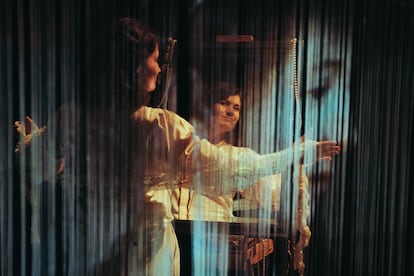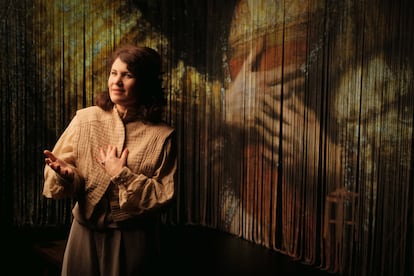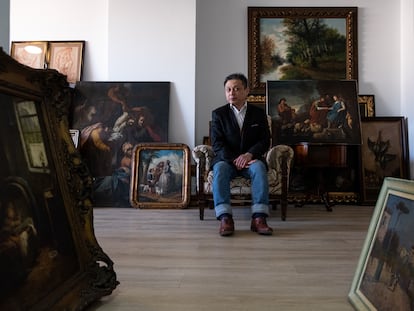The return of Rembrandt’s abandoned lover
Geertje Dircx cared for the painter’s wife and son. But she ended up imprisoned in a House of Correction when she asked him for money to support herself after they’d lived together for eight years


The voice of Geertje Dircx (ca. 1610-1656), the woman Rembrandt managed to have locked up in a House of Correction despite their having been lovers, has been heard louder than ever in the Netherlands this year.
Dircx had cared for Saskia, the painter’s wife, who died of tuberculosis. She was the nanny of the couple’s son Titus and worked in their home for eight years. When she was displaced by a younger maid, Hendrickje Stoffels, Dircx was brave enough to sue the artist over an unfulfilled promise of marriage. The judges ruled in Geertje’s favor, but Rembrandt had given her some of his late wife’s jewelry and wanted it back. The artist succeeded in having her imprisoned after accusing her of being a prostitute. On December 21, Dutch actress and producer Julika Marijn closed her theatrical tour in which her one-woman show recovered a figure who paid dearly for defending her rights against the Golden Age’s most renowned artist.
Geertje Dircx’s story is that of a strong woman, but one who was socially vulnerable because of her poverty, and whose demands must not tarnish the irreproachable master painter. For decades, the image of the scorned lover who tried to take advantage of him by asking for a lot of money predominated. “Today, with the #MeToo movement, there is a change in the way we approach her,” says Epco Runia, the head of collections at the Rembrandt House Museum (Rembrandthuis) in Amsterdam. In a telephone conversation, he explains that when Dircx’s story appeared in the municipal archives at the end of the 19th century, “Rembrandt was already a heroic figure, which, in turn, had to do with the country’s unification. In the 20th century, he practically became a saint.” The United Kingdom of the Netherlands, which included today’s Belgium, Luxembourg and part of Germany, was dissolved in 1830 when Flanders and Wallonia, the southern provinces, separated. Belgium gained its independence in 1839, “and then a Dutch national hero was needed,” says the expert. Belgium has Rubens. “Rembrandt fits what is considered to be the Dutch identity: a plain man who goes his own way. His mocked lover’s fate, however, is a painful example that there are other sides of the [story] when you are sanctified.”

Although Dircx was locked up for only five years of her 12-year sentence, it was not until the 1960s that more original documents were recovered, giving a different picture of what happened. For its part, the museum itself only included her in its narrative after 2000, despite the fact that Dircx lived and suffered in the same building that receives thousands of tourists today. “I am interested in the woman’s position, and she [was] impressed by the great artist; they [did not] have any children together, and when she [was] no longer needed she [was] easily locked away,” explains Julika Marijn. Rembrandt forms part of the Dutch national identity “and we have almost erased this history, so I’m trying to bring it out of the shadows,” she declares. “It is her voice and the voices of many other women that have also not been heard, and I amplify that echo to this day in my work.”
Geertje Dircx was widowed at the age of 24 and went to work with Van Rijn —Rembrandt’s surname— around 1642. She was 32 years old at the time and cared for Saskia until the latter’s death shortly thereafter. She acted as a second mother to Titus, the couple’s son. At that time, the painter delivered his monumental work The Night Watch, and shortly after he became a widow, Rembrandt began a romantic relationship with Dircx for all to see. Saskia (née Van Uylenburgh) was the upper-middle-class daughter of a Dutch mayor, and her will stipulated that if the artist remarried he would lose what she left him as an inheritance, including several very valuable jewels. Dircx knew this, and when Rembrandt gave her a diamond ring in the shape of a rose, along with other gold and silver pieces that belonged to Saskia, she considered it to be a form of engagement, a type of security in life. It is possible that Geertje posed for him, as Saskia and Hendrickje did, and was his model for the oil painting Sarah Waiting for Tobias (1645).

According to writer Simone van der Vlugt, who tells Dircx’s story in her book Rembrandt’s Lover, the artist wanted to get her off his back when he fell in love with Hendrickje. “He offered Geertje some money, [and she] asked for more to be able to support herself,” the author says. Dircx was about to turn forty and was being thrown out of what had been her home, so she stood up to the artist and availed herself of the jewels. In the Golden Age, giving a woman a ring was tantamount to a marriage, as she argued before the Court of Matrimonial and Family Affairs in Amsterdam. The judges ordered Rembrandt to give her an allowance, which she thought was too little. When their relationship was going well, Dircx had signed a will in which the jewels were bequeathed to Titus. In fact, the boy was his mother’s rightful heir, so their ultimate fate was sealed. “She fought for her life, but I think Rembrandt was infuriated that she didn’t return the jewels. He was also shocked that she ended up in front of the judge and wanted to teach her a lesson,” the author notes.
While her situation was being decided, Dircx did two things that later precipitated her downfall. She stayed at The Black Ship, a disreputable inn on Amsterdam’s waterfront, and she pawned the jewelry. “The judge ruled that they were hers, although she could not sell or pawn them so that [the jewels] could be passed down to Titus in due course. That must have bothered the artist so much that he sought a way to accuse her of prostitution,” says Van der Vlugt. He succeeded. It has not been proven with documentary evidence that Rembrandt bribed the witnesses, but a brother of his former lover, Pieter, testified that Geertje had practiced prostitution. Since the inn was in a bad neighborhood, that idea caught on. “She was an abandoned woman in need of money and that’s why she left the jewelry as collateral. In any case, the jewels have never been found. When she died, they were not listed in the inventory of her assets.” Before she was locked up, Rembrandt offered Dircx 200 guilders to get the jewels back plus an annual allowance of 160 guilders. On paper, it was a good deal. The problem was that Dircx was alone and needed funds to be able to pay for the necessary support if she reached old age. Julika Marijn, who combined songs and videos with the artist’s paintings in her one-woman show, believes that “Geertje must have been very intense, but she was very courageous when facing a creator who was, paradoxically, praised for his compassionate gaze.”

The House of Correction where she was admitted in 1650 was in the city of Gouda, to the west. The inmates there had to spin and sew non-stop. It housed prostitutes, thieves and those believed to be fallen women; although the conditions were terrible, the sentences were not usually very long. Geertje, however, was sentenced to 12 years; the writer claims that Rembrandt paid a fee to keep his ex-lover imprisoned. “There’s information missing, but there are documents that show he was involved.” On May 31, 1655, after Geertje had been confined for five years and when she was already very ill, her friend Trijn Jacobs managed to get her out of prison. She lived only one more year, but she did not give up her efforts. Rembrandt died in 1669 and his former lover appeared among his creditors.
Saskia and Rembrandt had a happy marriage. Hendrickje bore the artist a daughter named Cornelia; she stayed with him for fifteen years and helped him by opening an art store with Titus. They had the painter as an employee and sold his works, preventing him from trading in person because of his debts. Nevertheless, Rembrandt died in poverty and angry at most of his clients, friends and patrons. Epco Runia notes that it is now more difficult to have a single image of the artist, so, at the museum, “we try to present him as a human being with strengths and weaknesses.” The Rembrandt House Museum is now displaying the Framing Rembrandt in Amsterdam exhibition, which reviews four centuries of forging the painter’s image. The exhibit is open until February 2024.
Sign up for our weekly newsletter to get more English-language news coverage from EL PAÍS USA Edition








































